Thailand lies between Myanmar, Cambodia, and Laos, carrying the influence of different cultures and traditions. From Indian to Chinese influence, Thai culture is entrapped with a diverse history of Buddhist religion, scenic wonders, friendly people, and is well known as Southeast Asia’s “Land of Smiles”.
Thailand carries unique attributes such as cultural attractions, languages, traditional clothing, Thai cuisine, and values. Becoming the center of trade, economy, and tourism, Thai people carry a unique feeling of friendliness and charm. They welcome you into their country with blessings and comfort.
From Chiang Mai to Bangkok to Krabi, Thailand is embraced by uniqueness wherever you look. You will always find tradition, culture, or a hidden smile that will be embedded with meaning. The lifestyle they live is in itself unique, challenging everyday modernity with old Buddhist morals and local manners.
What is unique about Thai culture?
1. Cultural and historical attractions
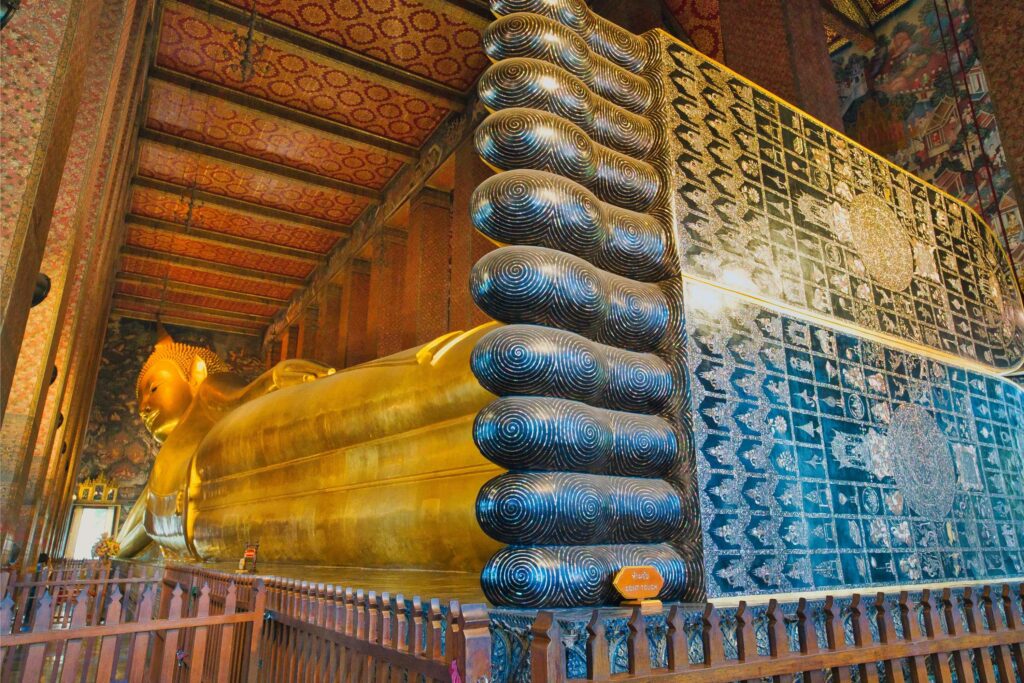
Home to cultural and historical attractions, Thailand values its famous and complex buildings to symbolize long-lasting tradition and the fight for freedom. Such valuable visits tell unique stories and complement the lives of the people living around them.
Bangkok carries the tradition of holding on to some of the most visited monuments in the region. These include The Grand Palace, Wat Pho- home to the 151 ft long Buddha statue, the Temple of the Emerald Buddha (Wat Phra Kaew), and the Temple of Dawn (Wat Arun).
It is also close to the historic city of Ayutthaya – the second Siamese capital.
Other regions such as Phuket also carry a significant tradition of holding on to old temples. For example, the Wat Chalong was built around the reign of King Rama II in the early 1840s. The temple is made of structures, halls, gilt-covered statues of Luang Poh Cham, and other ex-abbots of the temple.
The Grand Pagoda is further decorated with paintings that depict the Buddha’s life story through various images.
Another significant location is the Heroines Monument. Established in 1785, it holds the tradition of the sisters Chan and Mook, who led people to Phuket during the Burme invasion. Taking note of women’s empowerment, Chan was the wife of the governor of Thalang and rose to defend Phuket after her husband’s death. She and her sister received the honorary titles of Thao Thepkasattri and Thao Sri Sunthorn.
Phuket’s Old Town is another classic favorite; once a small mining area in the 19th century, it grew to hold Sino-Portuguese architecture and carries a mixture of Western and Chinese influence.
Lastly is the Big Buddha – perched on the top of a 380-meter hilltop in Nakkerd Hills. It is a new man-made attraction called the Big Buddha or the Ming Mongkol Buddha. The structure is dedicated to His Majesty, King Bhumibol Adulyadej, in honor of his 80th birthday. The smaller Brass Buddha was dedicated to HM Queen Sirikit.
2. Religion
Thailand’s religion of Theravada Buddhism is practiced around the nation. Influenced by Hindu practices and traditional Chinese beliefs, you will see Thais wearing amulets, caring talismans, or monks crossing the street. Not only is religion a part of the temple but a part of everyday life; you will see shrines at hospitals or buildings and witness superstitious stories of ghosts and spirits in Thai stories and movies.
▸ READ MORE about religion in Thailand here.
3. Languages
Thailand is also unique for its tremendous cultural diversity. Thai people have grown up in various cities around the country, learning at different types of schools in either the south or northern Thai provinces.
Thai is not a monolith; there are different dialects spoken across different sides of the region. Some of the regional dialects include Isan, Phuan, Phu, Galung, and Thai Dam.
Other popular languages include Chinese, Pali, Sanskrit, Khmer, Portuguese, and Austronesian. With 51 indigenous tongues spoken in the country, you can find all kinds of people- some even half Thai or half Japanese, Hindi, Korean, or German. (Source)
4. Thai Clothes
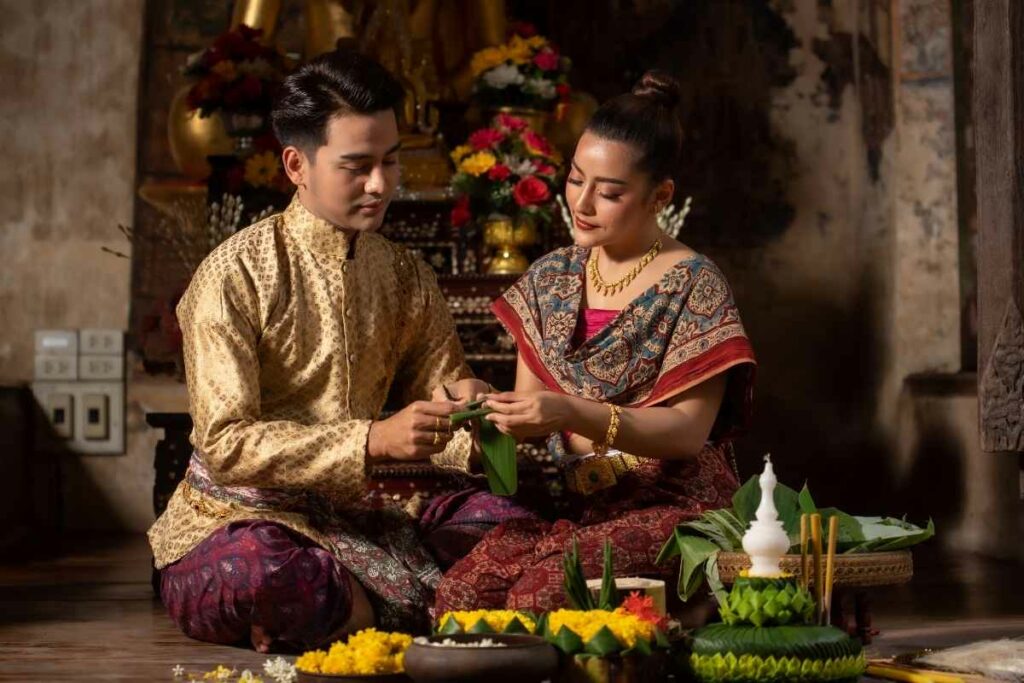
Thailand carries a traditional dress that is worn by men, women, and children. The official dress is called “chut thai,” which means “Thai Outfit”; available in different styles, patterns, garments, and accessories, the dress can be worn at formal occasions or particular cultural festivals.
Chut Thai for women are called Ruean Ton, Chakkri, Siwalai, Boromphiman, Chitlada, Amarin, Chakkraphat, and Dusit. The male chut thai are known as Suea Phraratchathan, translated as “royally-bestowed shirt.” It is a buttoned shirt with a long collar. (Source)
Other dress codes are simply Western. Thai people are mostly seen in skirts, dresses, shorts, or jeans. However, they value appropriate attire, especially when visiting temples and entering religious sites.
▸ READ MORE about Thai traditional dress here.
5. Thai Cuisine & Food Culture
Most people visit Thailand for the food culture. One of the most popular traditional cuisines in the world, Thai food is home-cooked and served all across the border.
From America to India, you will find rich Thai flavors wherever you go. However, the real Thai flavor can only come from its local routes.
Thai cuisines carry regional significance and are heavily influenced by different neighboring countries and cities within Thailand. With a combination of sweet, spicy, bitter, and sour flavors, you can always expect to have a tasty bite each time.
Thai people also follow cultural eating practices such as eating with a fork and spoon. Licking fingers is considered offensive in most parts of Thailand. Sharing is also caring; dishes are served simultaneously and to be eaten together with rice. (Source)
▸ READ MORE about Do Thai people use chopsticks? here.
Some of the most popular dishes include:
Guay Teow:
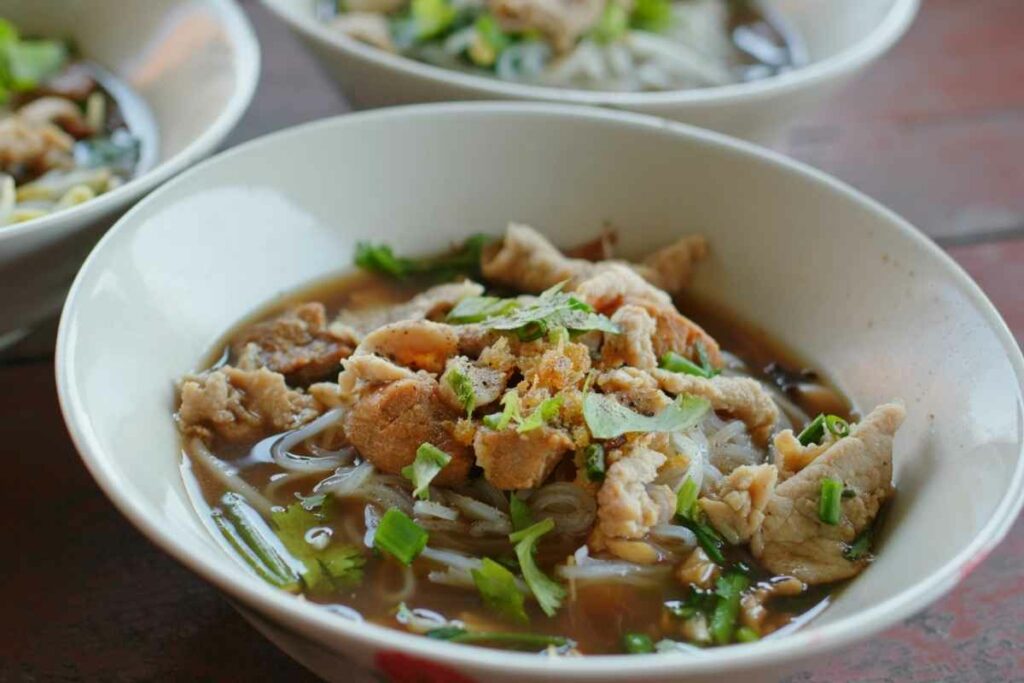
Guay teow is a noodle soup found all around the country. It is made of chicken, pork, or beef (it can be made vegetarian-friendly). You can further add wontons or meatballs to the broth.
Tom Yum Goong:
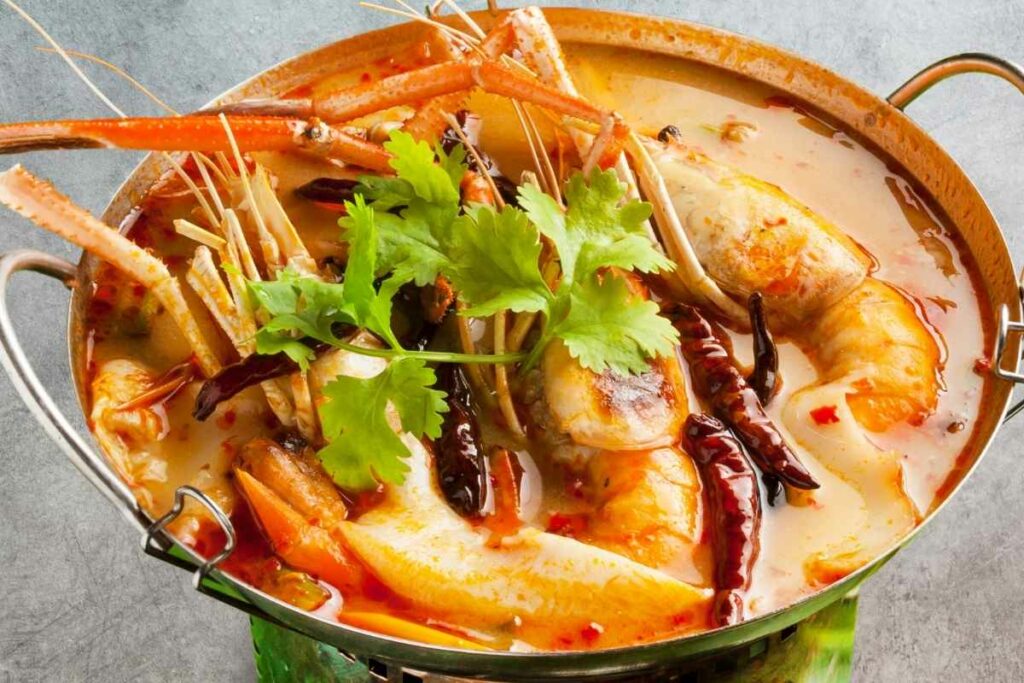
This iconic bowl is rather spicy; created with lemongrass, chili, kaffir lime leaves galangal, fresh lime juice, fish sauce, and shallots, it is also served with fresh mushrooms, prawns, and coconut cream.
Tom Kha Gai:
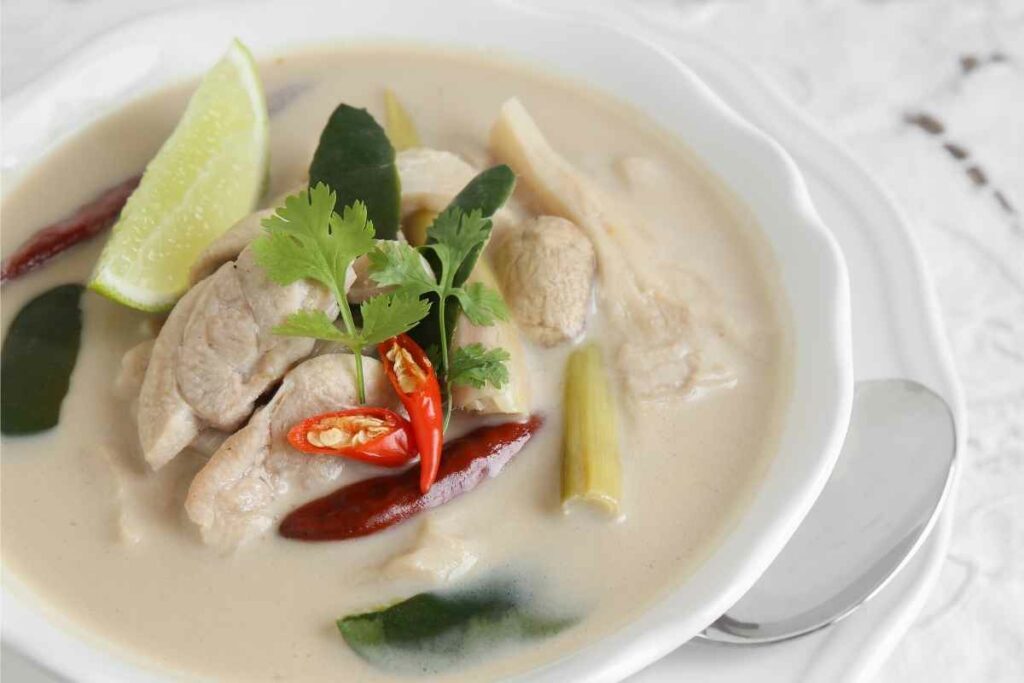
It is a chicken coconut soup uniquely made of coconut milk and comes with vegetarian options as well.
Som Tam:
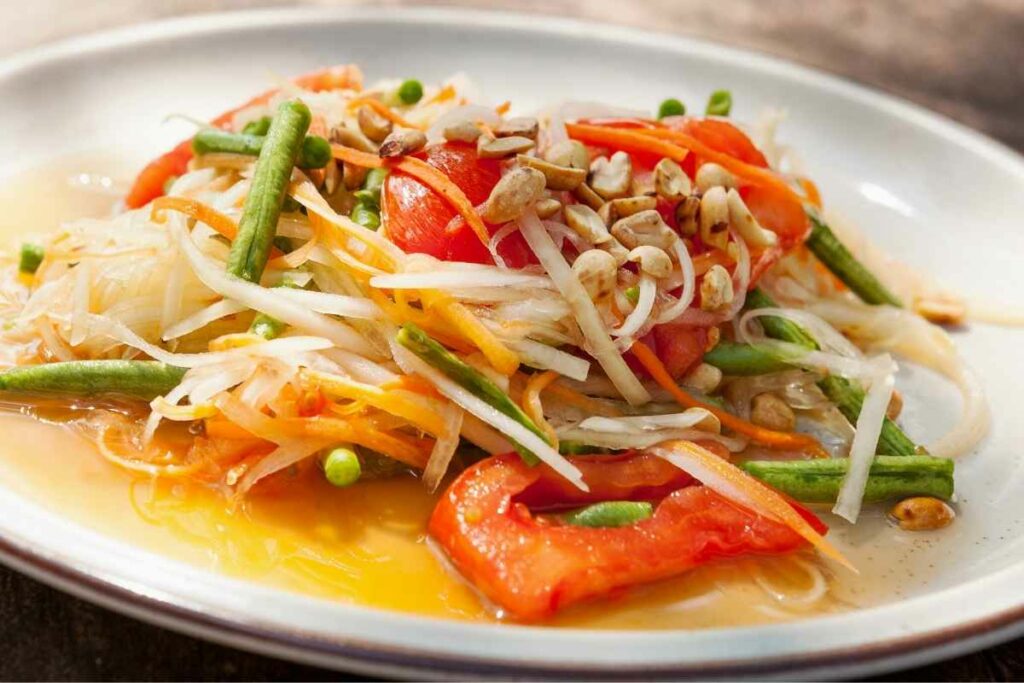
Known as a spicy green papaya salad, it comes from Isaan in Northeastern Thailand and is one of the most popular dishes in Thailand. It is made from shredded papaya, tomatoes, peanuts, carrots, dried shrimp, runner beans, palm sugar, tamarind pulp, lime juice, garlic, chilies, and fish sauce.
Yam Pla Dook Foo:
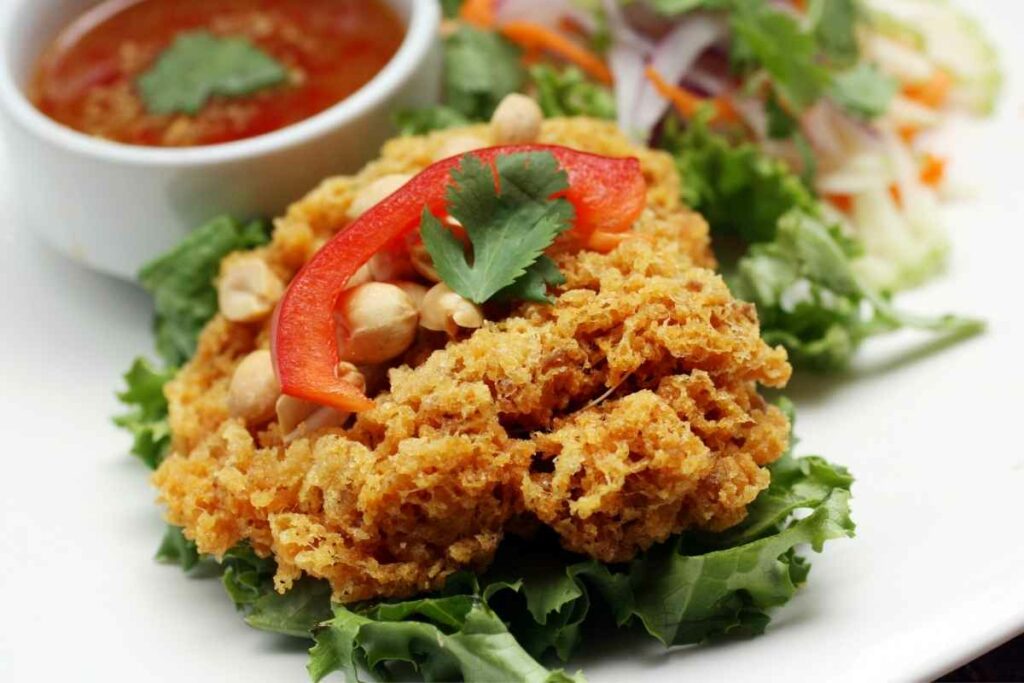
A fried catfish with green mango salad- a scrumptious fish salad with a crispy yet sweet and sour mango salad.
Yam Talay:
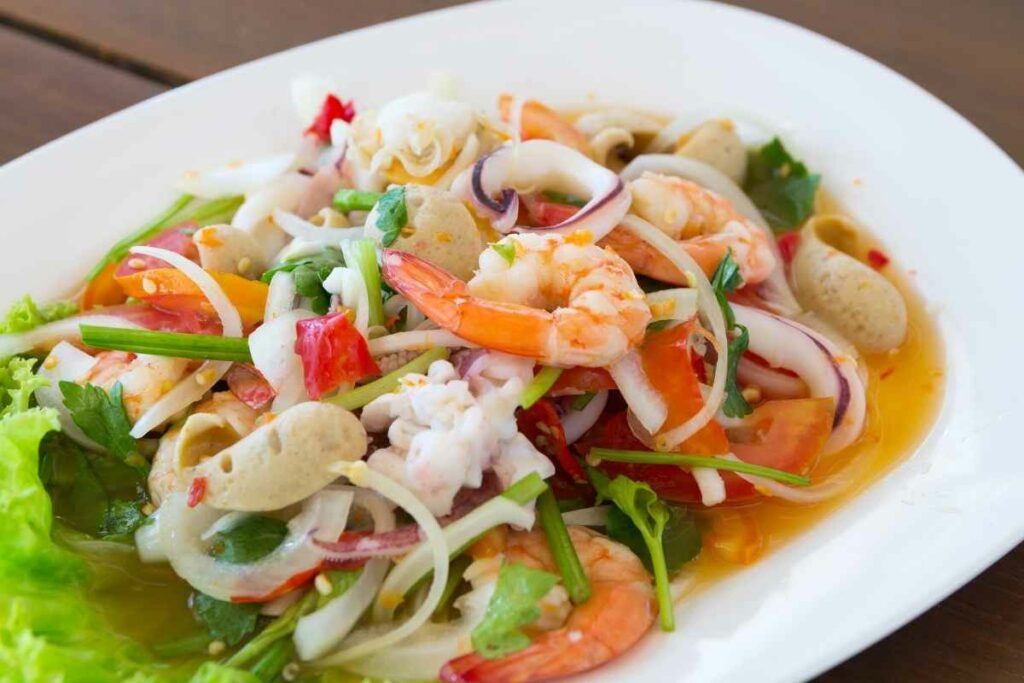
Yam talay is a spicy seafood salad that can be served as a healthy option; it combines shrimp, squid, mussels, crabmeat, and scallops.
Gaeng Keow Wan:
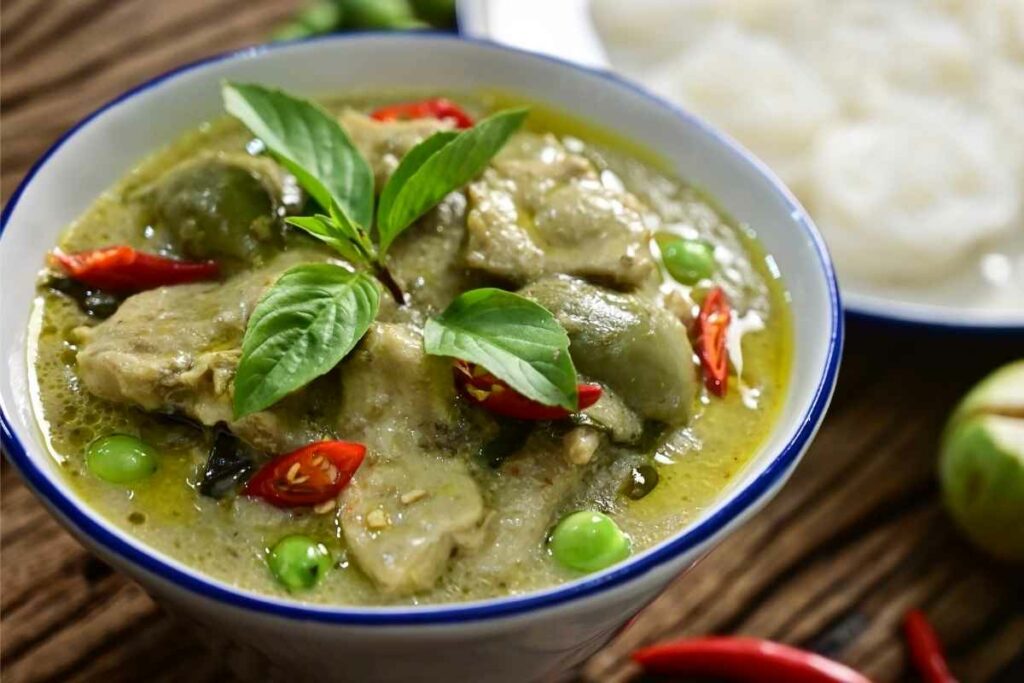
Known as the famous green curry, it originates from central Thailand and is the spiciest dish. Made of green chilies, ginger, eggplant, and coconut milk, steamed rice contributes to bringing down the spice level.
Pad Phak:
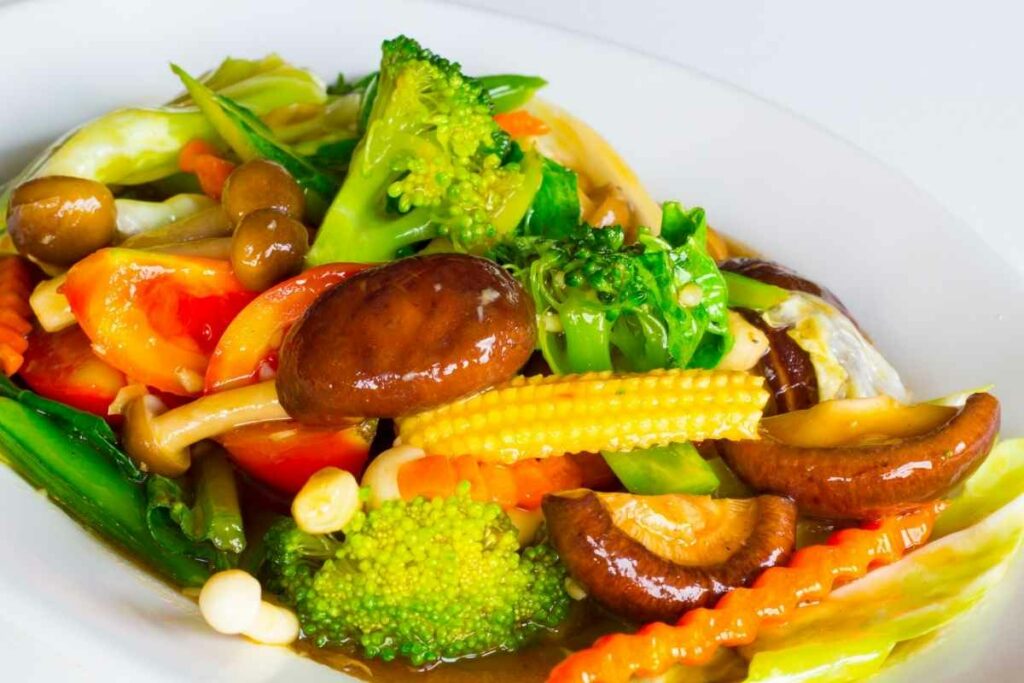
This classic Thai dish is made of fried vegetables; mixed with sugar, salt, and spices. This is perfect for vegetarians.
Kai Jeow:
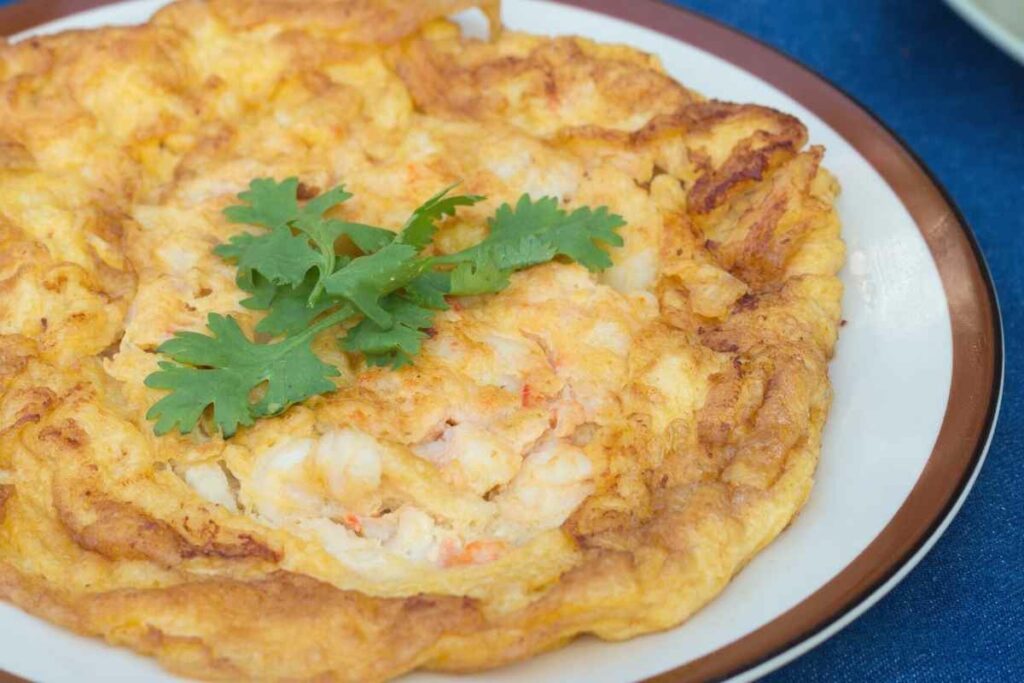
Known as the simplest of Thai dishes, it is a rich-in protein Thai omelet made of vegetables.
Kao Niew Ma Muang:
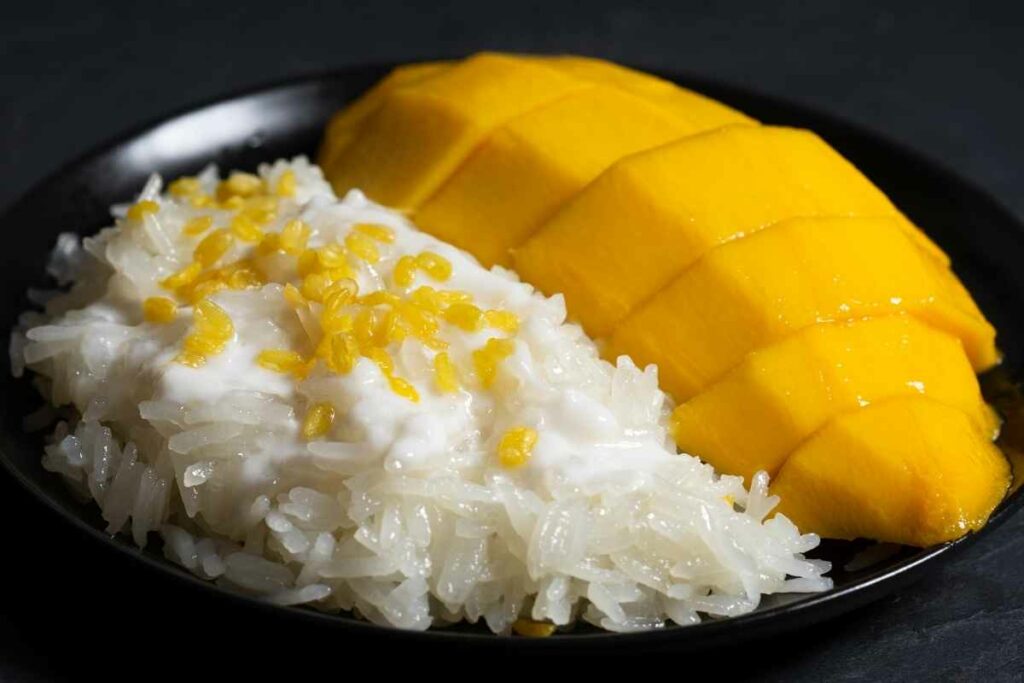
Known as the famous mango and sticky rice, this is Thailand’s most popular crowd-pleaser,, dessert.
Gai Tod:
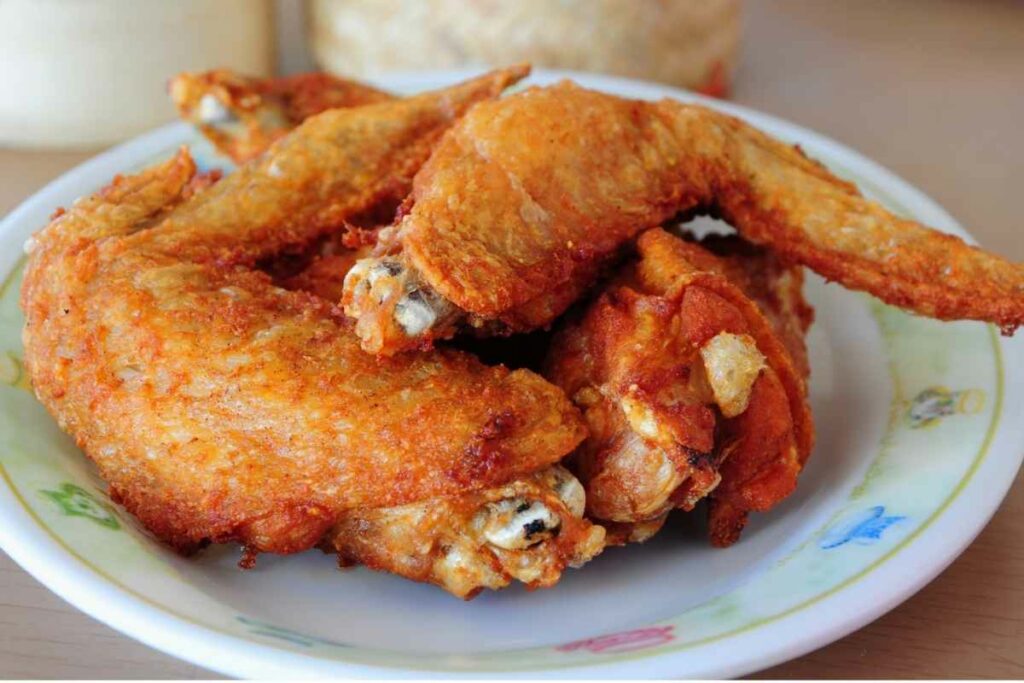
Gai tod is fried chicken, popularly prepared by marinating drumsticks of chicken wings with other spices.
6. Cultural Codes
Like any other country, Thailand comes with a list of rules and regulations. With strict religious and cultural codes, it pays note of modesty and respect for not only foreigners but for the locals, the King, and the Government.
Here are a few important pointers to take note of:
- Do not touch the head
It is important not to touch another Thai person’s head or mess with their hair; the head is considered the most sacred part of the body and should not be touched without permission. If it is done by mistake, apologize immediately.
- Always take off your shoes
Thai people value feet to be further away from the head; they are considered the lowest part of the body spiritually and physically. When entering someone’s home, make sure to take your shoes off as you would for temples and businesses.
- Stay calm
Thai people value calmness and patience; losing your mind or raising your voice is unacceptable and is considered an act of losing control. Thailand does not consider success from those who are aggressive or loud. They follow the motto of being “Jan yen yen,” which means having a cool heart instead of a “Jai rawn”- a hot heart.
- Duck down when passing through two people
When walking around the country, you will notice that Thais bend their heads down when passing through two people in a conversation. This is considered a polite gesture and a respectful walkthrough; this also applies to someone on the street or strangers whom you do not know.
- Do not point
Pointing is considered a big NO in Thailand. Although your friends will not take offense to your pointing in a casual conversation, it is not considered modest. Pointing at monks, pictures of the royal family, or people, in general, is considered rude. Instead of pointing someone out with your finger, bend your hand downwards or lead your fingers upward.
▸ READ MORE about Dos and don’ts in Thailand here.
Other unique Thai cultural values and traditions
Family matters

Thai people value the importance of family and extended family, rather than typical Western countries. You might be shocked by the number of siblings a Thai person has – it is likely that those people are actually their cousins. However, Thai people value all close people as their brothers and sisters.
It is also normal for extended families to live close by or within the same house, maintaining strong relationships among the youngsters and elders in the family. Children are also often raised by grandparents or extended family, similar to Southeast Asia.
As the children grow older, they are expected to take care of the elders in the family and provide financial means of stability.
▸ READ MORE about Family life in Thailand here.
Thai people value status
Thais are also cautious when it comes to financial stability. Status is a huge part of Thai culture.
Attaining family connections, jobs, education, income, and age, these components help contribute to how a person is. Status might not be fixed, but Thai people can gain or lose status when their circumstances change.
Thais perform different versions of “Wai” depending on someone’s status, such as the highest earner paying the bill when the group goes out to eat. However, it is not just about money. Thai people have a way of greeting and talking to each other. Certain words are used to indicate a person’s age.
Seniority is a big deal in Thailand. For example, “Pee” is used before introducing an older person’s name and “Nong” before using a younger person’s name. These added references allow modesty and respect. They also provide the context of who is higher in status.
▸ READ MORE about Thai etiquette here.
Loss of respect is a big deal
Respect and shape are also important concepts in Thailand. The use of Wai is just one way to show respect. Others include visiting someone’s home without a gift or not removing your shoes before entering someone’s house. Disrespecting people can be done in a variety of different ways.
It is important to avoid such attitudes or yelling in public which can allow for individuals in the community and family to face punishment and set a bad example for the younger generation.
Patriotism is high
Thai people value national pride. They cling to it just as much as European countries, also since it is one of the main countries to have never been colonized.
The national anthem is regularly played in malls, at events, and every day during school assemblies. The national flag is also hung proudly around buildings, and the King’s Anthem is played before movies begin in the cinema.
Thai people love to endure love for their country and religion and accept foreigners to do the same when they visit.
Thailand is certainly unique.
Thailand is more than just a tourist destination of tropical beaches and partying. Home to the influence of different cultures and religions, you are embraced by uniqueness wherever you look.
Known as the ‘Land of Smiles,’ friendliness will take you places and help you find meaning in various places. From historical attractions to languages, clothing, and cuisines, you will find inscribed meanings in the Thai way of life, their values, and what they represent.
Like always, if you want to discover more about Thailand, stay guided by ThaiGuider. You might learn something you never knew about this unique country.
▸ CHECK OUT all our guides on Thai Culture here.
THINKING ABOUT A TRIP TO THAILAND?
I am working on a FREE Thailand Travel Guide with a FULL 7 Day Itinerary. Be the first to receive it!
Thank you for signing up.
Something went wrong.
